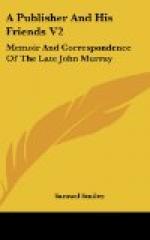CHAPTER XI
MURRAY’S DRAWING-ROOM—BYRON AND SCOTT—WORKS PUBLISHED IN 1815
During Mrs. Murray’s absence in Edinburgh, the dwelling-house at 50, Albemarle Street was made over to the carpenters, painters, and house decorators. “I hope,” said Mr. Murray to his wife, “to leave the drawing-room entirely at your ladyship’s exclusive command.” But the drawing-room was used for other purposes than the reception of ordinary visitors. It became for some time the centre of literary friendship and intercommunication at the West End. In those days there was no Athenaeum Club for the association of gentlemen known for their literary, artistic, or scientific attainments. That institution was only established in 1823, through the instrumentality of Croker, Lawrence, Chantrey, Sir Humphry Davy, and their friends. Until then, Murray’s drawing-room was the main centre of literary intercourse in that quarter of London. Men of distinction, from the Continent and America, presented their letters of introduction to Mr. Murray, and were cordially and hospitably entertained by him; meeting, in the course of their visits, many distinguished and notable personages.
In these rooms, early in 1815, young George Ticknor, from Boston, in America, then only twenty-three, met Moore, Campbell, D’Israeli, Gifford, Humphry Davy, and others. He thus records his impressions of Gifford:
“Among other persons, I brought letters to Gifford, the satirist, but never saw him till yesterday. Never was I so mistaken in my anticipations. Instead of a tall and handsome man, as I had supposed him from his picture—a man of severe and bitter remarks in conversation, such as I had good reason to believe him from his books, I found him a short, deformed, and ugly little man, with a large head sunk between his shoulders, and one of his eyes turned outward, but withal, one of the best-natured, most open and well-bred gentlemen I have ever met. He is editor of the Quarterly Review, and was not a little surprised and pleased to hear that it was reprinted with us, which I told him, with an indirect allusion to the review of ’Inchiquen’s United States.’.... He carried me to a handsome room over Murray’s book-store, which he has fitted up as a sort of literary lounge, where authors resort to read newspapers, and talk literary gossip. I found there Elmsley, Hallam, Lord Byron’s ‘Classic Hallam, much renowned for Greek,’ now as famous as being one of his lordship’s friends, Boswell, a son of Johnson’s biographer, etc., so that I finished a long forenoon very pleasantly.” [Footnote: “Life, Letters, and Journal of George Ticknor,” i. 48.]
The following letter and Ticknor’s reference to Gifford only confirm the testimony of all who knew him that in private life the redoubtable editor and severe critic was an amiable and affectionate man.
Mr. Gifford to John Murray,




